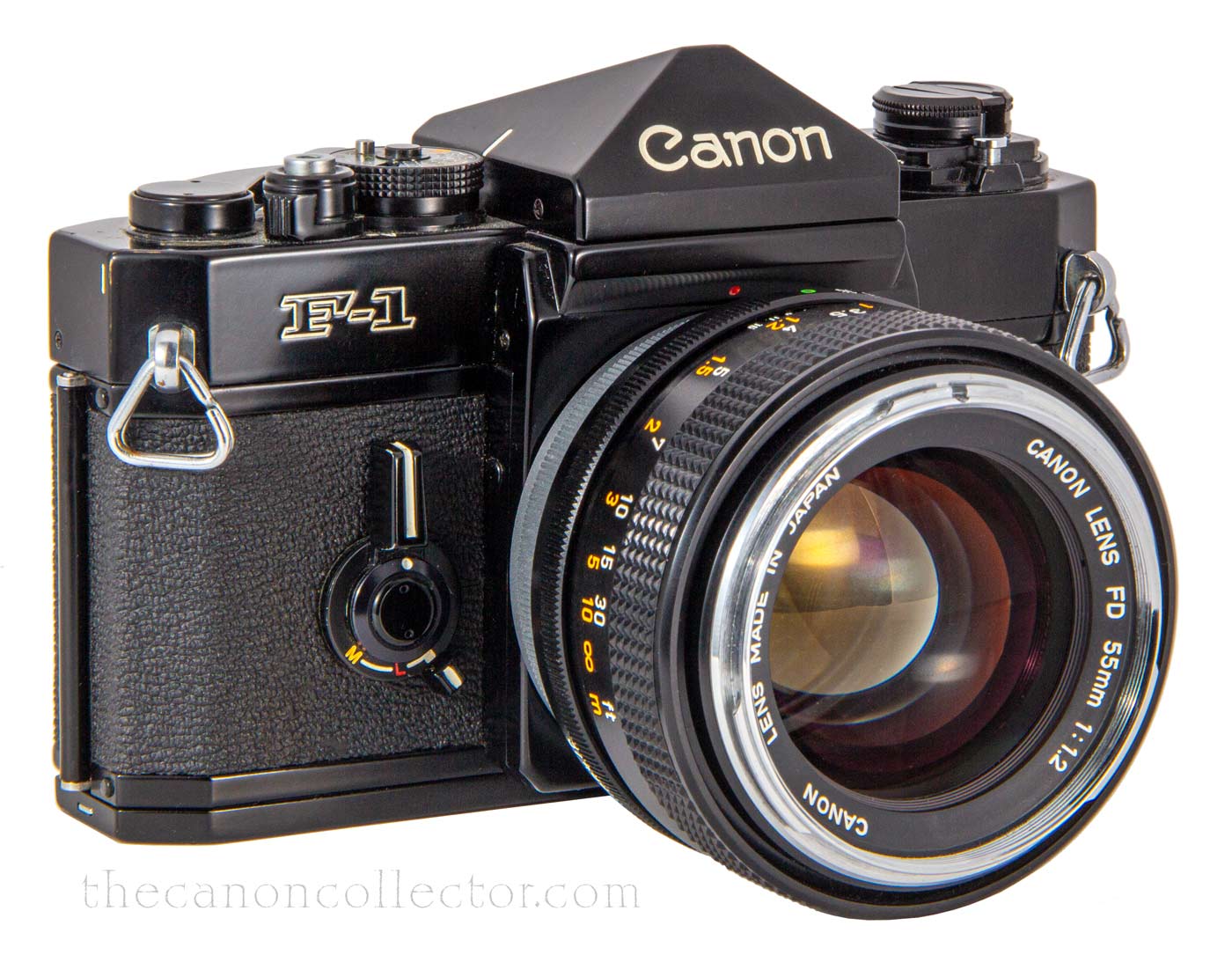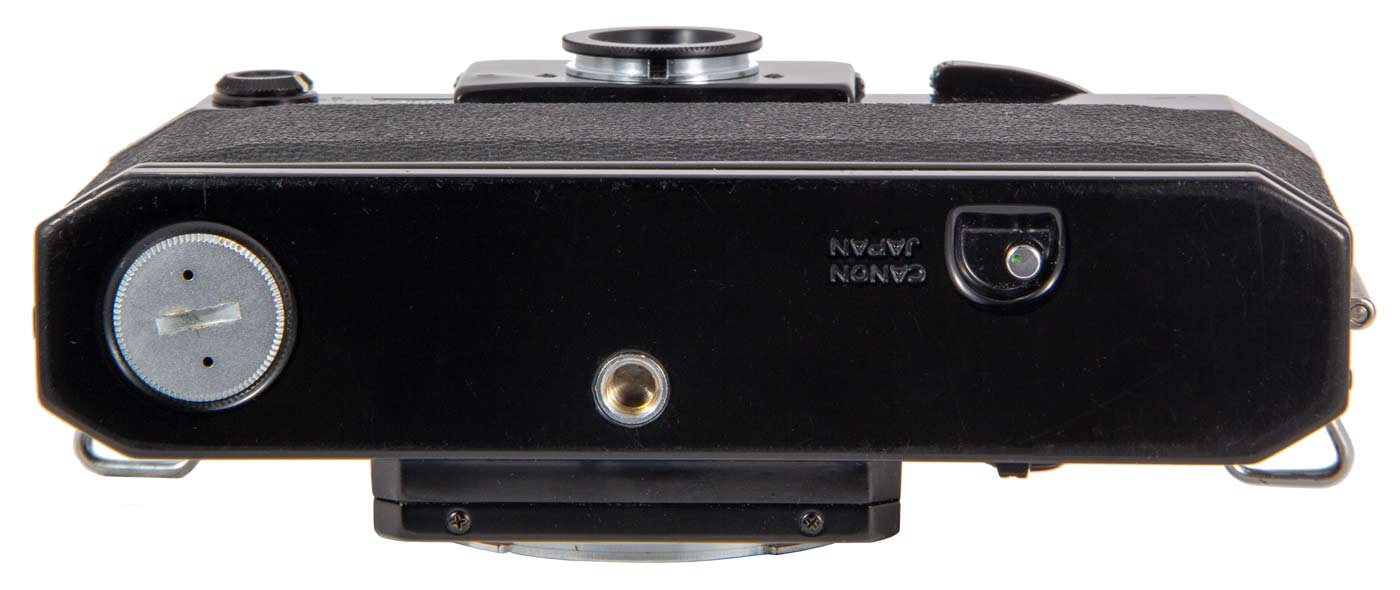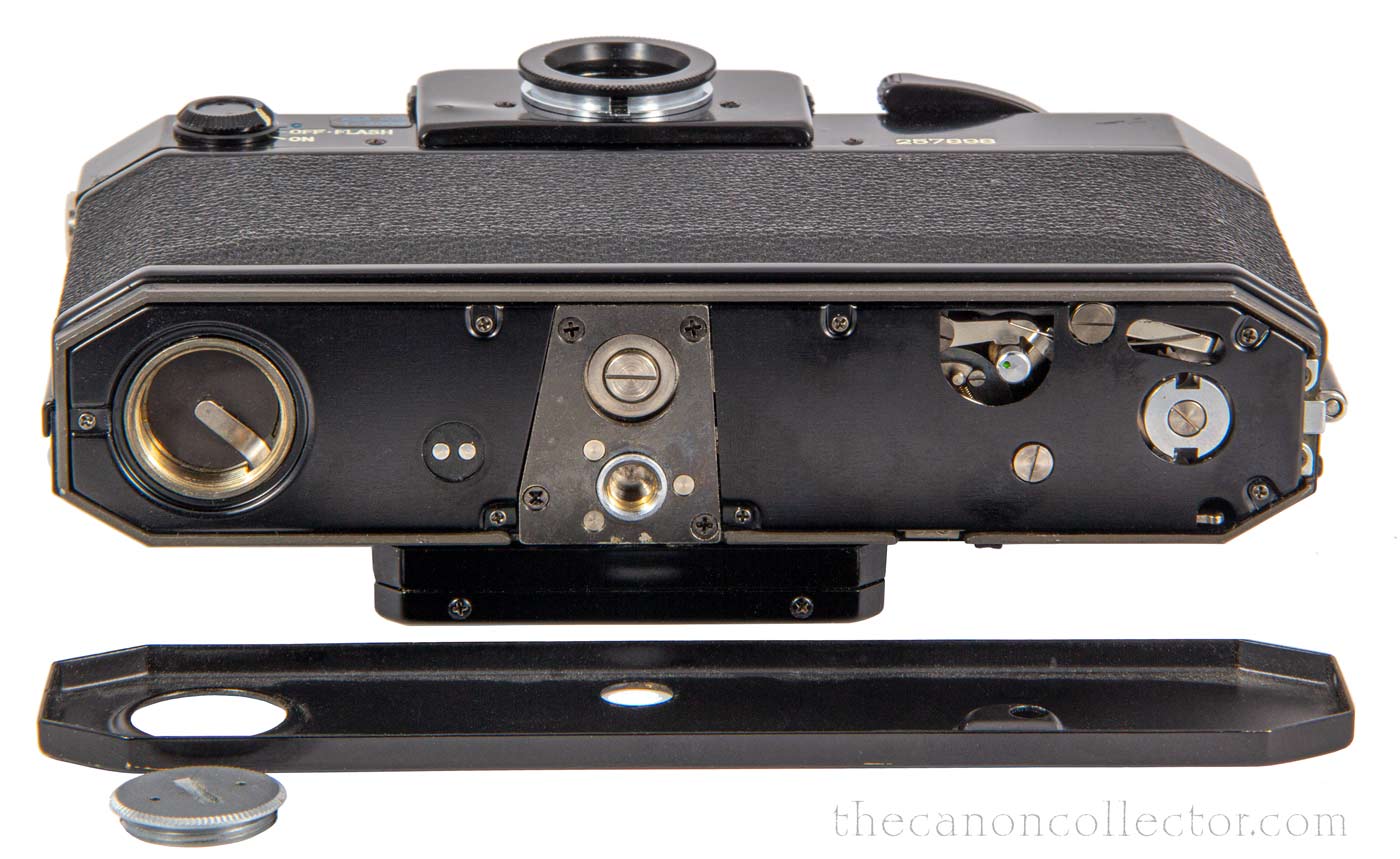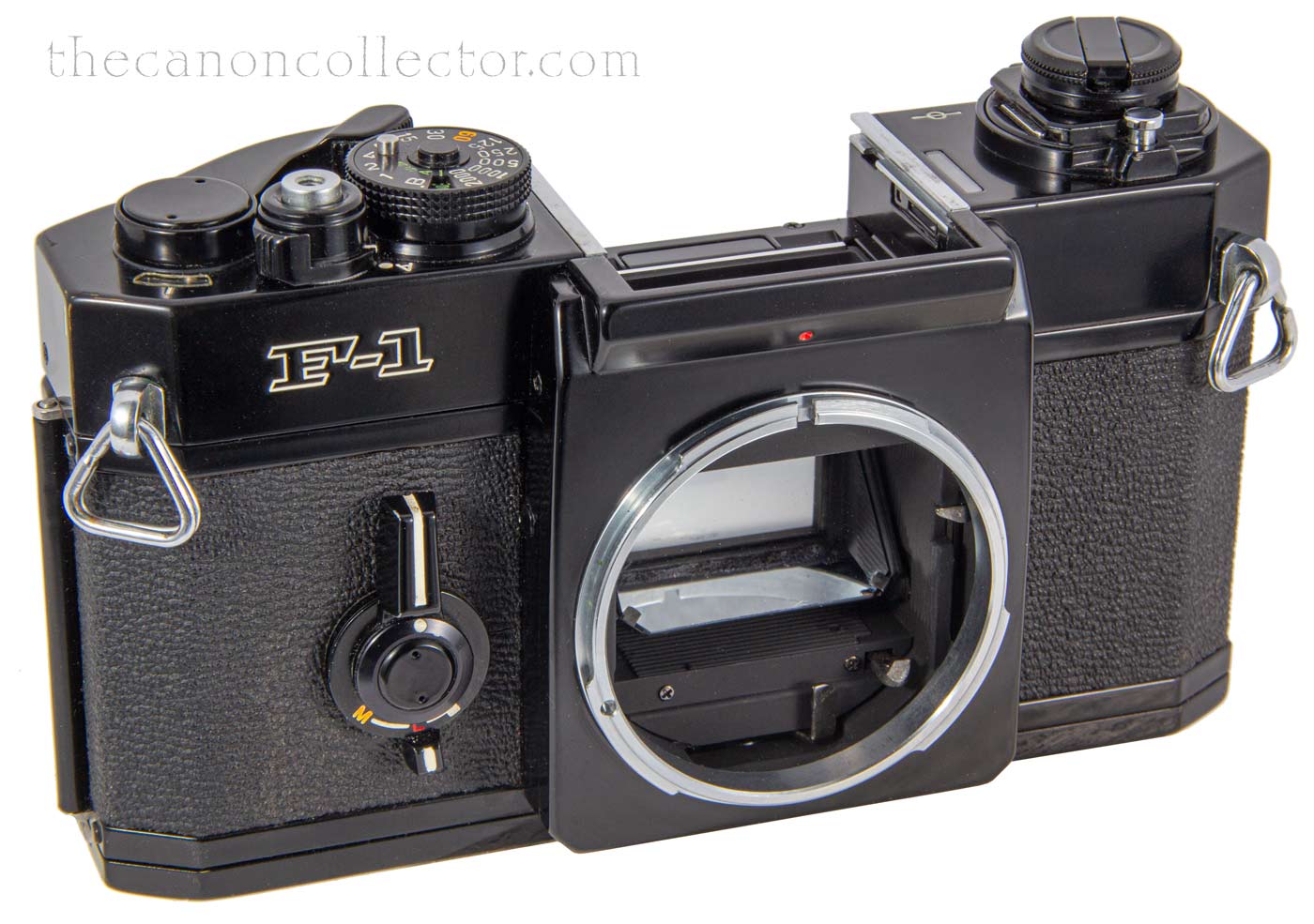Canon began single lens reflex production in 1959 with the Canonflex. Unfortunately it was introduced in the same year that Nikon came out with the very excellent Nikon F which was to dominate the professional and technical photography market for the next ten years.
The iconic first model of the Canon F-1 camera.

The Canonflex was not able to
compete head to head with the F1 although it was a very capable
camera overall. In total four
variations on the Canonflex
came out from 1959 thru 1962
and then they faded from view.
Canon regrouped and in 1964
began the “F” series with the FX
followed by the FP, Pellix, FT
and finally the TX in 1968. These
initial “F” Series cameras all had
the FL lens mount. All were excellent cameras aimed at the advanced amateur user. But Canon still had no camera that could compete for the professional.
Takeshi Mitarai was a Tokyo physician and a good friend of Saburo Uchida who was one of the founders of the Precision Optical Instruments Laboratory in 1933. Mitarai was a supporter of Uchida’s efforts and actually did a little accounting work on the side for the fledgling company. In 1942 he was appointed President of Precision Optical and held that position until 1974.
Mitarai was not happy with the poor showing by the Canonflex and the inability of Canon to capture a signifigant share of the professional camera market. To change this situation became a personal project of his and he authorized the expenditure of resources and treasure to develop a professional Canon camera.
The camera was in development for over five years. Not only did the camera have to be created but it was decided that the then current FL lens mount was not sufficient for the demands of TTL metering. And as the F-1 began to emerge it was necessary to create a suite of attachments necessary to market a complete new “system”. It was a major undertaking.
Canon announced the arrival of the F-1 in March of 1970. Then at the Photokina Show held in Cologne Germany between the 3rd and 11th of October that year it appeared for the public to see and handle.
The New York Times for 1 November 1970 on page 129 ran an article about Photokina in which the following appeared:
“….One of the most dramatic bids for attention was the introduction of the 35mm Canon F-1 single lens reflex camera as a full blown system ready to compete with the established makes. …”
On 17th thru 25th of April 1971 the National Association of Photographic Manuafacturers held a Photo Expo at the McCormick Place Convention Center in Chicago. Again the F-1 and many of its accessories were on display.
As often happens when new cameras are introduced, it took some time for
production to ramp up and the camera was not generally available to the public until well into 1972. The Canon Museum says that it was first “marketed” in March of 1971.
It was on the F-1 that the new FD lens mount first appeared (and on the FTb which was announced at the same time). The new mount was backward compatible with the FL lenses (in stop down metering mode) and to some extent also with the R lenses of the Canonflex although they had to be operated strictly as manual lenses.
From the front the original F-1 looks very much like the other “F” Series cameras. Note the flat top deck. The New F-1 is not flat but rather the shutter speed dial is on a raised step which breaks this flat appearance.
Top deck is all one level. To open the back pull up on the rewind crank while pressing the silver button just above it in the picture. Between the speed dial and the film advance lever is the On-Off switch. On Canon cameras of this era the red “L” signifies the “Off” position.
The bottom plate is plain and flat. There is the film rewind button, tripod mount socket and cover for the battery compartment. The battery powers the light meter only. Without a battery the camera can still be used as a manual camera.
When you open the battery compartment the bottom plate lifts off to reveal the power attach points for film winders and other accessories. Mounting of most accessories on the bottom requires the removal of the bottom plate.
The back cover is another identifying feature: there is no holder for the end of the film box to remind of which film you have loaded. However because the backs are so easy to change around this is not a foolproof clue.
Identifying the F-1
Identifying the F-1 shouldn’t be a problem one would think. They have a big ‘F-1″ painted on the front. Well, nothing with Canon is that easy.
When the F-1 was introduced Canon said that they would support it for 10 years. They wanted customers to feel they were buying into a system that was going to be a long term standard they could rely on.
However, technological improvements in cameras advanced faster than anticipated, and customer suggestions pointed out areas that could be improved, so in 1976 Canon introduced modest changes to the F-1. It was still the same camera and all the attachments still fit but it was different. Canon continued to simply call it the F-1. Collectors, however, have come to call this second version the F-1n or the ‘second model’. This camera continued in production until 1981.
In 1981 the F-1 was beginning to lag behind current technology and Canon refreshed the line with a completely updated F-1. This camera was very different. The earlier cameras were basically manual cameras with a battery powered light meter. This updated model was redesigned internally and had become an electronically controlled camera. Canon called it the ‘New F-1’. But, again, it simply had the designation ‘F-1’ on the front.
To further confuse things there was a high speed model with a pellicle mirror and an olive drab colored version both of which were also labeled F-1. So, be aware that just because a camera says ‘F-1’ on the front, you still may not know which camera you have.
We shall deal with each model on its own page and then the Accessories separately. Here, on this page, we are looking at the original F-1 only. To distinguish it from the other models look for the following:
| 1. | Flat top deck – means it is not a New F-1 |
| 2. | Plain back – No film reminder holder – there is one on the F-1n. Not a good test because backs could have been switched at some point. |
| 3. | No plastic tip on rewind lever as on the F-1n. |
| 4. | Top ASA setting of 1600 whereas New F-1 goes to 3200. |
In side profile the F-1 looks very much like its “F” Series siblings. Its when you pick it up that you realize from the weight that it is not the same inside.
The F-1 ships with the Eye Level Pentaprism Viewfinder. It is not considered an accessory as this is part of the original camera.
The Pentaprism is removed by depressing two buttons on either side of the prism and pushing the assembly to the back of the camera.
Ad for the Canon F-1 from 1971.
Not only is the operation smooth but the camera is beautiful. The black finish is not quite glossy but it is a deep black that almost appears absorb light. It is simply beautiful.
Rather than describe the operation of the camera here it is best to simply read the manual which is available on the right above.
I think it silly that camera reviews have sample photographs because that is something created by the lens, not the camera. Only exception is, of course, if the lens is fixed on the camera like in the PowerShot cameras and others of that type.
The F-1 was intended for professional users. We know about sports photography, and portraits but there are other areas that you don’t think of so often. Wildlife photography is one. Scientific work is a big area. You need cameras to photograph traces on oscilloscopes, to photograph scientific experiments, to operate remotely and unattended, to record dangerous events such as rocket launches, even to fly in space. This is a big area and all of this was the intended market for the F-1.
For this reason, besides being gorgeous, it is rugged and reliable. Canon says that it is tested to be reliable for over 100,000 shutter actuations.
As we look at the Accessories we will discuss some of these applications. It is quite a camera as we shall see.
Handling the F-1
Using this camera is very like any other manual film camera. The back swings open, you load the film and you take pictures. But two things stand out as different.
The first is the feel of the camera. This is a brick! It feels like a solid block of brass. It is heavy and feels like a precision instrument. Secondly, all of the controls are silky smooth. There are no rough edges here. If I am going to shoot film, the F-1 is my ‘go to’ camera.
Instruction Manual for the original F-1 Camera.
In the Collection I have the following:
| Collection No.: | C-112 |
| Serial No.: | 257898 |
| Date of Acquisition: | 7 July 2016 |
| Condition: | Excellent ++ (no brassing) |
| Notes: | This camera is fully functional at all shutter speeds. Light meter functions as intended. I use standard batteries and the effect on exposure is less than an f stop. This is well within the tolerance of modern film. |
In the Collection I also have:
| Collection No.: | C-281 |
| Serial No.: | 134029 |
| Date of Acquisition: | 30 January 2019 |
| Condition: | Excellent ++ (very slight brassing) |
| Notes: | This camera is also fully functional at all shutter speeds and light meter functions as intended. |

This website is the work of R. Flynn Marr who is solely responsible for its contents which are subject to his claim of copyright. User Manuals, Brochures and Advertising Materials of Canon and other manufacturers available on this site are subject to the copyright claims and are the property of Canon and other manufacturers and they are offered here for personal use only.















